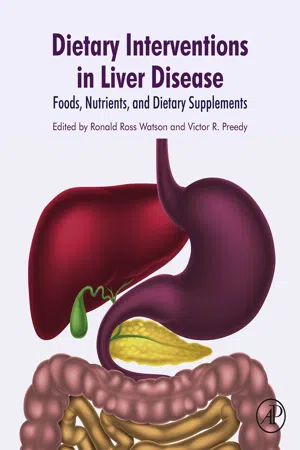
Dietary Interventions in Liver Disease
Foods, Nutrients, and Dietary Supplements
- 428 pages
- English
- ePUB (mobile friendly)
- Available on iOS & Android
Dietary Interventions in Liver Disease
Foods, Nutrients, and Dietary Supplements
About this book
Dietary Interventions in Liver Disease: Foods, Nutrients, and Dietary Supplements provides valuable insights into the agents that affect metabolism and other health-related conditions in the liver. It provides nutritional treatment options for those suffering from liver disease. Information is presented on a variety of foods, including herbs, fruits, soy and olive oil, thus illustrating that variations in intake can change antioxidant and disease preventing non-nutrients that affect liver health and/or disease promotion. This book is a valuable resource for biomedical researchers who focus on identifying the causes of liver diseases and food scientists targeting health-related product development.- Provides information on agents that affect metabolism and other health-related conditions in the liver- Explores the impact of composition, including differences based on country of origin and processing techniques- Addresses the most positive results from dietary interventions using bioactive foods to impact liver disease, including reduction of inflammation and improved function
Frequently asked questions
- Essential is ideal for learners and professionals who enjoy exploring a wide range of subjects. Access the Essential Library with 800,000+ trusted titles and best-sellers across business, personal growth, and the humanities. Includes unlimited reading time and Standard Read Aloud voice.
- Complete: Perfect for advanced learners and researchers needing full, unrestricted access. Unlock 1.4M+ books across hundreds of subjects, including academic and specialized titles. The Complete Plan also includes advanced features like Premium Read Aloud and Research Assistant.
Please note we cannot support devices running on iOS 13 and Android 7 or earlier. Learn more about using the app.
Information
Major Dietary Interventions for the Management of Liver Disease
Abstract
Keywords
1. Introduction
Table of contents
- Cover image
- Title page
- Table of Contents
- Copyright
- List of Contributors
- Acknowledgments
- Section I. Overview of Liver Health
- Section II. Fruits Improve Liver Health
- Section III. Herbs and Plants for Treating Liver Disease
- Section IV. Dietary Macronutrients and Micronutrients for Healthy Liver Function
- Section V. Toxic Dietary Materials Including Alcohol-Induced Liver Dysfunction: Treatment
- Index